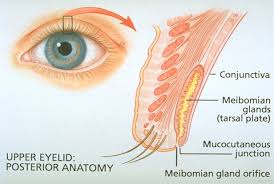 The meibomian glands, also known as tarsal glands are a special kind of sebaceous gland at the rim of the eyelids inside the tarsal plate.
The meibomian glands, also known as tarsal glands are a special kind of sebaceous gland at the rim of the eyelids inside the tarsal plate.
Meibomian glands are specialized sebaceous glands that line the eyelid margin and secrete lipids that form the superficial layer of the tear film.
There are approximately 25 glands in the upper eyelid, and 20 in the lower eyelid.
They are responsible for the supply of meibum, an oily substance that prevents evaporation of the eye’s tear film.
Meibum prevents tear spillage onto the cheek.
Meibum traps tears between the oiled edge and the eyeball, and makes the closed lids airtight.
There are approximately 50 glands on the upper eyelids and 25 glands on the lower eyelids.
When dysfunctional can cause dry eyes, and contribute to blepharitis.
Meibum, meibomian gland secretions, composition of meibum is extremely complex and very different from that of sebum.
Lipids are a major component of human meibum, and more than 90 different proteins have been identified in such secretions.
Inflammation of the meibomian glands causes the glands to be obstructed by thick waxy secretions.
Such obstruction leads to dry eye, and formation of free fatty acids which irritate the eyes and sometimes cause punctate keratopathy
Meiobian gland dysfunction is more often seen in women.
Factors that contribute to meiobian gland dysfunction include age and/or hormone imbalance.
Treatment includes warm compresses or expression of the gland.
In some cases antibiotics or steroids are prescribed.
